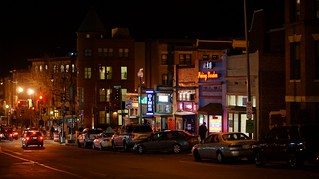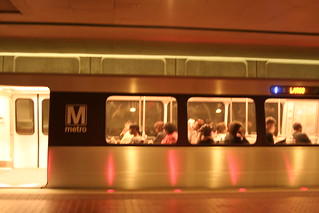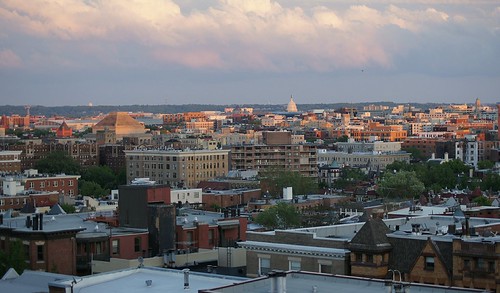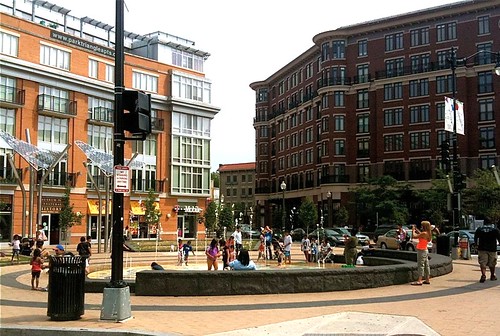DC population and housing trends bode well for US central cities

Posted August 12, 2013 at 1:32PM
It’s hard to believe now, but Washington, DC was a “shrinking city” for six of the last seven decades, having lost population every decade since the 1940s: Indeed, from a high of 802,178 in 1950, the city’s population plummeted to 572,059 in 2000, a drop of 29 percent. (For comparison, Baltimore’s population dropped 31 percent during the same time period; Milwaukee lost 19 percent between 1960 and 2000.)
Now, as I’ve written before, I think it is the metropolitan region’s population, not the central city’s, that is most relevant to both the economy and the environment. If one looks only at the central-city population, most every big city in the country lost population in the second half of the 21st century. The metro region is the real “city,” regardless of archaic legal boundaries, and all but a few were actually growing and hollowing out, not shrinking, as population fled to the suburbs.
The failure to control sprawl is a huge and mostly untold story of the shrinking-city phenomenon. Much has been made of the supposed collapse of Detroit, for example, but the population of Detroit’s metro region as a whole has been remarkably stable over the years, reaching a high of 4,307,470 in 1970 and declining less than one percent to 4,292,060 in 2012. Only the central city has been shrinking.
 Back to Washington, the DC region as a whole was booming during the years in which the city’s population was shrinking. But all the growth was in the suburbs. Still, the health of the central city matters a great deal, especially to the environment. Centrally located neighborhoods generate substantially less driving and related emissions than do outer locations, due both to fewer vehicle trips per person and to shorter driving distances, on average.
Back to Washington, the DC region as a whole was booming during the years in which the city’s population was shrinking. But all the growth was in the suburbs. Still, the health of the central city matters a great deal, especially to the environment. Centrally located neighborhoods generate substantially less driving and related emissions than do outer locations, due both to fewer vehicle trips per person and to shorter driving distances, on average.
All indications are that DC has turned things around and is now growing significantly. The estimated population in 2012 was 632,323, up ten percent since 2000. This is on the leading edge of a national trend of population recovery in central cities, now growing faster (though still not cumulatively as much) than their suburbs. Demographic forces and a growing preference for urban lifestyles suggest that the trend will only strengthen over time. (My only concern is that the growth in central DC has not been particularly family-friendly. The public school system, in particular, remains remarkably underperforming.)
Indeed, an article written by Tara Bahrampour and published over the past weekend in The Washington Post featured the growing number of aging Baby Boomers who are moving from outer suburbs into DC and its closest suburbs:
“Surveys of boomers’ preferences show that they are more interested in ‘smart growth’ areas than in sprawl. And they are such a large generation that even if only a small percent of them embrace urban life, the effect could be dramatic, [AARP spokesperson Amy] Levner said.”
The article quotes a real estate agent who specializes in a transit-rich corridor in close-in Arlington, Virginia (right across the Potomac River and part of the original District of Columbia) as saying that a quarter of his clients are boomers. This, too, is a national trend, says Bahrampour:
“Between 2000 and 2010, more than a million baby boomers moved out of areas 40 to 80 miles from city centers and a similar number moved to within five miles of city centers, according to an analysis of 50 large cities by the online real estate brokerage Redfin.”
It’s not just boomers, of course, since all generations are participating in the city’s renaissance, particularly Millennials (born between the early 1980s and early 2000s) with their decided preference for city living.
The result is that the housing market in inner-city Washington and its closest suburbs remains the strongest in the region. I’ve previously reported on how housing prices have held steady or increased near downtown at the same time that outer suburban prices have declined or failed to keep pace.  A chart published in the Real Estate section of Saturday’s Washington Post confirmed the trend: the median sales price of single-family houses and townhomes in the District was up 14 percent from January through June of 2013, compared to the same period a year earlier. (The chart does not appear to be online, but it was published on page 9 of the print edition of the Real Estate section on August 10, 2013.)
A chart published in the Real Estate section of Saturday’s Washington Post confirmed the trend: the median sales price of single-family houses and townhomes in the District was up 14 percent from January through June of 2013, compared to the same period a year earlier. (The chart does not appear to be online, but it was published on page 9 of the print edition of the Real Estate section on August 10, 2013.)
The trend is geographically focused on the city, reports the Bahrampour article:
“Prices in the Washington-area suburbs have not risen as quickly as in its urban cores. Whereas two decades ago it cost more per square foot to move to the suburbs than to the city, that trend has now reversed, [real estate analyst Chris] Leinberger said.”
This is good news for the environment. Look for these patterns to continue in a central city or close-in suburb near you.
Related posts:
- New DC data confirm real estate recovery strongest in central & transit-served locations (March 26, 2013)
- New research confirms central-city comebacks (December 18, 2012)
- Why I support the DC building height restrictions (November 19, 2012)
- Central cities now growing faster than suburbs, confirming trends for walkable lifestyles, shorter commutes (June 29, 2012)
- Managing the increasing urbanization of Washington: sensitivity required (May 29, 2012)
- New housing forecast mostly good for walkable communities (May 17, 2012)
- How the evolving housing market will help sustainable communities (April 4, 2012)
- Geography of housing recovery favors cities and walkable neighborhoods (October 26, 2011)
- Which part of Detroit, if any, really needs "right-sizing"? (June 9, 2011)
- Housing preference analysis: we have too much large-lot housing, too little urban housing to meet demand (May 2, 2011)
Move your cursor over the images for credit information.

